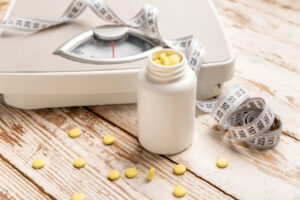There is a lot to learn if you are considering taking GLP-1 medications. There are many myths about GLP-1 medications that simply aren’t true. These weight loss drugs are often misunderstood, especially by people who form opinions based on clickbait headlines or hearsay without ever doing their own research.
However, one thing you’ve likely heard that does hold some truth is that GLP-1s can cause gastrointestinal side effects. Stomach issues are common, especially when first starting or increasing your dose. What is not true is that these symptoms happen to everyone, continue throughout treatment, or that they can’t be prevented or managed.
In this article, we’ll explain why digestive side effects are a common complaint for some people taking GLP-1 medications and walk you through a simple nutrition protocol we use in our clinics that helps patients minimize and often eliminate stomach discomfort and stay consistent with their treatment.
Why GLP-1 Medications Often Cause Gastrointestinal Side Effects
GLP-1 medications work by mimicking the effects of a natural hormone in the body called glucagon-like peptide-1. This hormone plays a key role in blood sugar regulation, appetite control, and digestion, which are key factors in why many people have issues with their weight despite diet and exercise.
GLP-1 medications like semaglutide and tirzepatide no doubt work. They are among the best medications for treating obesity and helping people lose weight. However, when GLP-1 levels are increased through these medications, it can trigger gastrointestinal (GI) side effects in some people, especially those taking higher doses.
The most common GI issues reported from GLP-1 weight loss drugs include:
- Nausea
- Constipation
- Diarrhea
- Bloating
- Heartburn or acid reflux
- Excessive burping or gas
- Feeling overly full, even after small meals
The reason? There could be a few factors. As mentioned, sometimes it has to do with improper dosage, which can be avoided by taking a smaller dose (which has many benefits) and/or slowly titrating up under the guidance of a qualified GLP-1 healthcare provider.
Also, some people are simply more susceptible to GI side effects when taking any medication, especially those with underlying digestive conditions like ulcerative colitis, Crohn’s disease, or irritable bowel syndrome (IBS).
But often, the root cause of GI upset when taking GLP-1s is due to changes in gut motility, particularly delayed gastric emptying—which is the slowed rate at which food leaves the stomach and enters the small intestine.
While this is part of how the medication helps reduce appetite and manage blood sugar, it can also sometimes lead to temporary digestive symptoms, particularly if dietary habits aren’t adjusted accordingly.
Many people take GLP-1s and never have any stomach issues. For those that do, they can range from mild to disruptive and can occur anytime during GLP-1 treatment, but are more likely to happen during the early phases of treatment or after dose increases.
The good news? In most cases, there is no need to stop taking the medication altogether. Typically, these side effects can be reduced or even prevented with the right nutritional strategies, additional medications, and/or dosage adjustments.
Nutrition Strategies to Help Alleviate Nausea and Gastrointestinal Issues While on GLP-1 Medications
If you’ve recently started a GLP-1 medication and are dealing with stomach issues such as nausea, bloating, gas, reflux, diarrhea, or constipation—you’re not alone. GI side effects are common for those on GLP-1 drugs, especially early on.
You don’t need to “wait it out” or suffer through it. In most cases, they’re manageable. With a few simple nutrition strategies and smart adjustments, you can reduce the discomfort and stay consistent with your plan.
1: Stay Hydrated
We get it—even drinking water can seem nauseating when you’re already feeling sick to your stomach or overly full. However, staying hydrated is one of the most important (and most overlooked) ways to manage GLP-1-related side effects.
Proper hydration keeps digestion moving and helps reduce symptoms like constipation, bloating, and even headaches. As a baseline, aim for at least half your body weight in ounces of water per day, and increase that amount if you’re working out, live in a hot climate, or are eating fewer water-rich foods.
But don’t rely on plain water alone. When your appetite drops and food intake is reduced, you’re likely getting fewer electrolytes like sodium, potassium, and magnesium. That imbalance can actually worsen nausea, fatigue, and dizziness. Try adding an electrolyte supplement to one or two bottles of water per day, or use a pinch of sea salt with lemon if you want a DIY option.
Also, take small sips, not big gulps, and don’t use a straw. When you drink through a straw, you tend to not only drink faster but also swallow more air.
2: Eat Smaller Meals
One of the ways GLP-1 medications work is by slowing down how quickly food moves through your stomach. That’s great for appetite control—but not so great if you eat a large meal and end up feeling overly full, nauseous, or bloated for hours afterward.
Even slightly overeating can leave you uncomfortable or queasy. Smaller, more frequent meals are much easier for your body to digest while on a GLP-1. Aim to eat 3–4 smaller meals per day, spaced about 3–4 hours apart. If that’s not realistic, at least break your meals into lighter portions and avoid eating until you’re “stuffed.”
The goal isn’t to force a ton of food when you are feeling sick to your stomach, but to make every bite count when you do eat, even if it’s just a small meal. So, when planning those meals, prioritize protein first.
Protein not only helps preserve lean muscle while you’re losing weight (which is crucial when on GLP-1 drugs), but it also keeps you full longer and helps stabilize blood sugar, which can reduce nausea and fatigue.
Build your meals around a protein source, then, if you feel you can stomach it, add small amounts of carbs, healthy fats, and fiber from veggies.
3: Eat Slower
When your digestion is already slowed down from GLP-1 medications, eating too quickly only adds to the problem. Fast eating increases the chance of overeating before your body has time to signal that it’s full, which can lead to nausea, bloating, or that uncomfortable “food just sitting there” feeling hours later.
Eating slowly also gives your body time to start the digestion process in the mouth—where it begins. Chewing thoroughly helps break down food mechanically and activates enzymes in your saliva that aid digestion.
Tips to help you slow down at mealtime:
- Chew each bite thoroughly
- Put your fork down between bites
- Take a few sips of water during the meal, but don’t chug
- Stop eating when you feel comfortably full, not when the plate is clean
Eating slowly is a simple change that can make a huge difference in how you feel after meals, especially when digestion is moving at a slower pace than usual due to GLP-1 medications.
4: Be Mindful of Meal Timing
Spacing meals out too closely can overload your slower-digesting stomach, while waiting too long between meals may increase nausea once you do eat.
A good rule of thumb is to wait at least 3–4 hours between meals and avoid lying down
right after eating, especially if you’re prone to heartburn or reflux.
If you’re fasting, which is a popular dieting method for those on GLP-1s, make sure your first meal of the day is light and easy to digest.
5: Consume High-Fiber Foods (Gradually)
Fiber helps regulate digestion and reduce constipation, but too much too quickly can worsen bloating or gas, especially if your body isn’t used to it. Increase fiber slowly, and be sure you’re drinking enough water to help it move through your system.
Focus on soluble fiber sources like:
- Oats
- Chia seeds
- Cooked vegetables
- Apples or pears (with skin)
- Ground flaxseed
These foods all have high fiber content but are often gentler than raw cruciferous vegetables or high-fat fiber bars, which can cause more discomfort.
6: Eat Foods That Are Gentle on the Stomach
When your digestion is slowed down because of GLP-1 medications and/or reduced food intake from not having much of an appetite while on weight loss medications, the types of food you choose can make or break how you feel after eating.
Greasy, spicy, fried, or ultra-processed foods are harder to digest and more likely to trigger nausea, bloating, or indigestion. High-fat meals, in particular, sit in the stomach longer and can worsen feelings of fullness or discomfort.
Instead, focus on meals and snacks that are both nutrient-dense and gentle on your digestive system. That means soft textures, cooked vegetables over raw, and mild flavors that provide nourishment without overwhelming your stomach.
Everyone tolerates foods a bit differently, but in general, here are a few gentle yet nutrient-rich foods to try. These foods are easy to digest, deliver key nutrients, and are less likely to trigger GI symptoms:
- Scrambled or hard-boiled eggs
- Bone broth or low-sodium chicken broth
- Rice cakes or crackers
- Mashed or baked potatoes (any variety)
- White rice
- Bread
- Greek yogurt (plain or low-sugar)
- Ripe bananas
- Steamed zucchini or spinach
- Lean protein like chicken, turkey, or white fish
- Oatmeal or cream of rice with chia or ground flax for added fiber
- Protein shakes made with water, low-fat milk, or a milk alternative
Choosing the right types of food can go a long way in easing nausea and promoting digestion. Just keep in mind that even healthy foods can be hard to tolerate if eaten in large amounts or too quickly, so pair this strategy with smaller portions and slower eating for best results.
Also, some of the foods listed above don’t contain much protein on their own. Don’t forget to prioritize protein above all else, even when you’re not feeling your best. For example, if you’re going to have rice cakes or bread, pair it with a scrambled egg or a small serving of cottage cheese. If you’re having fruit, blend it into a smoothie with a scoop of protein powder to help meet your needs without overwhelming your stomach.
You might also want to keep these meals bland and simple. Avoid overdoing it with condiments, sauces, or seasoning, which can further irritate your stomach or increase nausea. You can always reintroduce more variety once your symptoms settle and digestion feels more comfortable.
7: Go On A Walk After Meals
One of the simplest and most effective ways to support digestion, especially if you are experiencing constipation or feel bloated, is to move your body.
A short walk after eating can help stimulate digestive enzymes, encourage gastric motility, and reduce feelings of sluggishness, bloating, or fullness—especially important when you’re on a GLP-1 medication that slows digestion.
The key here is gentle movement, not an intense workout. Think 10–15 minutes of light walking, stretching, or even casual tidying up around the house. This helps your body process the meal without putting additional strain on your stomach.
Even better? Do it outside. Fresh air and natural light can work wonders for helping to reduce nausea and improve overall well-being. Again, just don’t overdo it—intense exercise too soon after eating can have the opposite effect.
8: Keep a Food Diary
Tracking what you eat and how you feel afterward can provide valuable insight. A food diary can help you pinpoint patterns like foods that trigger nausea, portion sizes that leave you feeling overly full, or specific ingredients that may not sit well with you while your digestion is slowed.
You don’t need to log calories unless that’s part of your plan. Just jot down:
- What you ate and drank
- Time of the meal
- How you felt after (bloating, nausea, fullness, etc.)
- Any supplements or medications taken with the meal
Bonus Tip
While this is not a nutrition strategy, you might also want to consider anti-nausea medications. Over-the-counter options like meclizine (Dramamine) or chewable ginger tablets may offer short-term relief from mild nausea. However, some OTC anti-nausea medicines can cause drowsiness, while many natural approaches aren’t always effective for ongoing symptoms.
Many providers will prescribe ondansetron (Zofran) alongside your GLP-1 medication, especially during the first few weeks or when titrating up to a higher dose. Zofran is typically taken as needed, not daily, and is well-tolerated by most patients.
If your nausea is severe or persistent, don’t attempt to tough it out—talk to your GLP-1 provider. They may adjust your dose, change your injection timing, or prescribe additional support to help you stay on track without unnecessary discomfort.
Conclusion
Digestive issues are one of the most common reasons people are hesitant to try GLP-1 medications or stop taking them. But with a few strategic changes to how and what you eat, as well as additional support if needed, most GI side effects can be minimized or avoided entirely.
Everyone’s body reacts differently to GLP-1s, which is why proper guidance matters. At Revive Health, every patient gets a personalized care plan based on their lab work, goals, and how their body responds.
That includes customized dosing, nutrition support, and ongoing monitoring to help you stay consistent and get results with less risk of suffering from gastrointestinal side effects that are common when taking GLP-1 weight loss drugs. If you’re starting or struggling with GLP-1s, our team of experienced weight-loss experts would love to help. Click here to find a Relive Health clinic near you.




